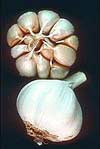Garlic
Jump to navigation
Jump to search
Garlic (Allium sativum), which many people believe has strong anti-microbial properties, as well as lowering cholesterol levels, has a number of side-effects that are relevant to body modification:
- It is a blood thinning agent and can reduce the ability of the blood to clot.
- When being taken in conjunction with diabetes medication, specifically sulfonylureas (chlorpropamide (DIABINESE), glimepiride (AMARYL), glyburide, etc.), it can lower blood sugar levels.
- Garlic can reduce levels of the protease inhibitor saquinavir and reduce the effectiveness of various HIV and other immuno-suppressor medications.
- Garlic enhances the immune system by promoting phagocytosis and by stimulating macrophages and T-cells (yes—this is in some disagreement with the previous point—garlic research is still in its infancy).
- Garlic is strongly antibiotic and antimicrobial and is considered a promising broad-spectrum therapeutic agent. It should be noted that if you're looking for this effect, you are better off eating the garlic raw than cooked (although cooking will have little effect on the other properties).
